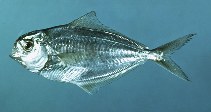Peprilus triacanthus (Peck, 1804)
Atlantic butterfish
Carregue seu(sua) Fotos e vídeos
Pictures | Imagem do GooglePeprilus triacanthus
Picture by Flescher, D.
Pictures | Imagem do GooglePeprilus triacanthus
Picture by Flescher, D.
Common names from other countries
Classificação / Names Nomes comuns | Sinônimos | Catalog of Fishes(Gênero, Espécies) | ITIS | CoL | WoRMS | Cloffa
> Scombriformes (Mackerels) > Stromateidae (Butterfishes)
Etymology: Peprilus: Greek, peprilos, paprax, certain fish from Tracia.
Etymology: Peprilus: Greek, peprilos, paprax, certain fish from Tracia.
Environment: milieu / climate zone / depth range / distribution range Ecologia
marinhas; estuarina bentopelágico; oceanódromo (Ref. 51243); intervalo de profundidade 15 - 420 m (Ref. 58426), usually ? - 55 m (Ref. 53006). Subtropical; 62°N - 26°N, 87°W - 52°W
Distribuição Países | Áreas da FAO | Ecossistemas | Ocorrências | Point map | Introduções | Faunafri
Western Atlantic: from Labrador (Ref. 58426) to the gulf coasts of Florida (Ref. 2702). Absent in Bermuda or Caribbean (Ref. 26938).
Comprimento de primeira maturação / Tamanho / Peso / Idade
Maturity: Lm 12.0 range ? - ? cm
Max length : 30.0 cm TL macho/indeterminado; (Ref. 7251); common length : 20.0 cm TL macho/indeterminado; (Ref. 2702)
Max length : 30.0 cm TL macho/indeterminado; (Ref. 7251); common length : 20.0 cm TL macho/indeterminado; (Ref. 2702)
Descrição suscinta Chaves de identificação | Morfologia | Morfometria
Espinhos dorsais (total) : 3; Espinhos anais: 3. This species is distinguished by the following characters: body oval to somewhat elongate, moderately deep (its depth 2.7 to 3 times in total length) and strongly compressed; eye medium-sized (its diameter 3.4 to 3.7 times in head length), surrounded by a small area of adipose tissue; snout short and blunt, lower jaw projecting somewhat beyond upper; mouth small, tip of maxillary not reaching to anterior eye margin; teeth in jaws very small, in a single row, while those in the upper jaw flattened and with 3 tiny cusps; dorsal and anal-fin bases very long (about equal in length), the anterior fin rays elevated, but fins not falcate, and both fins preceded by 3 short, weak, spines; caudal fin deeply forked; pectoral fins long (longer than head) and pointed; pelvic fins absent; a conspicuous series of 17 to 25 pores along anterior half of body under dorsal fin; lateral line high, following dorsal profile; scales small, present also on cheeks; caudal vertebrae 17 to 20; body color pale blue above, silvery below; numerous irregular dark spots on sides in live fish (fading after death) (Ref. 53006).
Forms large schools over the continental shelf, except during the winter months when it may descend to deeper water. Juveniles are generally found under floating weeds and jellyfish. Often found in brackish waters (Ref. 26938). Nerito-pelagic (Ref. 58426). Adults feeds mainly on jellyfish (Ref. 26938), squids, arrow worms, crustaceans and worms (Ref. 58426). Marketed fresh, smoked and frozen; eaten fried, broiled and baked (Ref. 9988). Mostly frozen and exported to Japan.
Ciclo de vida ou comportamento de acasalamento Maturidade | Reprodução | Desova | Ovos | Fecundidade | Larvas
Referência principal
Upload your references | Referências | Coordenador | Colaboradores
Robins, C.R. and G.C. Ray, 1986. A field guide to Atlantic coast fishes of North America. Houghton Mifflin Company, Boston, U.S.A. 354 p. (Ref. 7251)
Ameaça para os humanos
Harmless
Uso pelos humanos
Pescarias: espécies comerciais; peixe esportivo: sim
FAO(pescarias: produção; publication : search) | FishSource | Sea Around Us
Mais informação
Population dynamics
Parâmetros de crescimento
Max. ages / sizes
Length-weight rel.
Length-length rel.
Frequências de comprimento
Conversão de massa
Recrutamento
Abundância
Parâmetros de crescimento
Max. ages / sizes
Length-weight rel.
Length-length rel.
Frequências de comprimento
Conversão de massa
Recrutamento
Abundância
Life cycle
Reprodução
Maturidade
Fecundidade
Desova
Spawning aggregations
Ovos
Desenvolvimento dos ovos
Larvas
Dinâmica larval
Reprodução
Maturidade
Fecundidade
Desova
Spawning aggregations
Ovos
Desenvolvimento dos ovos
Larvas
Dinâmica larval
Physiology
Body composition
Nutrients
Consumo de oxigênio
Tipo de natação
Velocidade de natação
Visual pigments
Fish sound
Diseases & Parasites
Toxicity (LC50s)
Body composition
Nutrients
Consumo de oxigênio
Tipo de natação
Velocidade de natação
Visual pigments
Fish sound
Diseases & Parasites
Toxicity (LC50s)
Human related
Aquaculture systems
Perfis para aquacultura
Estirpes
Ciguatera cases
Stamps, coins, misc.
Aquaculture systems
Perfis para aquacultura
Estirpes
Ciguatera cases
Stamps, coins, misc.
Ferramentas
Livro eletrônico | Guia de campo | Chaves de identificação | Ferramenta auxiliar de frequências de comprimento | Ferramenta sobre a história de vida | Mapa de pontos | Classification Tree
| Catch-MSY |
Relatórios especiais
Checar Manutenção em Aquário | Checar Planilhas de Fatos sobre as Espécies | Checar Planilhas de Fatos sobre Aquicultura
Baixar XML
Fontes da internet
Aquatic Commons | BHL | Cloffa | Websites from users | Checar Observador de Peixes (FishWatcher) | CISTI | Catalog of Fishes(Gênero, Espécies) | DiscoverLife | ECOTOX | Faunafri | Fishtrace | GenBank(genoma, nucleotídeo) | GloBI | GOBASE | | Google Books | Google Scholar | Google | IGFA World Record | MitoFish | Otolith Atlas of Taiwan Fishes | PubMed | Reef Life Survey | Scirus | SeaLifeBase | Árvore da vida | Wikipedia(Ir para, procura) | World Records Freshwater Fishing | Registro zoológico
Estimates based on models
Preferred temperature (Ref. 115969): 5.1 - 24.7, mean 21.7 (based on 250 cells).
Índice de diversidade filogenética (Ref. 82804): PD50 = 0.5020 [Uniqueness, from 0.5 = low to 2.0 = high].
Bayesian length-weight: a=0.01230 (0.00867 - 0.01745), b=3.14 (3.04 - 3.24), in cm Total Length, based on LWR estimates for this species (Ref. 93245).
Nível Trófico (Ref. 69278): 3.9 ±0.0 se; based on diet studies.
Resiliência (Ref. 120179): Elevada, tempo mínimo de duplicação da população menor que 15 meses (K=0.8(?); tm=1).
Fishing Vulnerability (Ref. 59153): Low vulnerability (20 of 100).
Climate Vulnerability (Ref. 125649): Low vulnerability (22 of 100).




